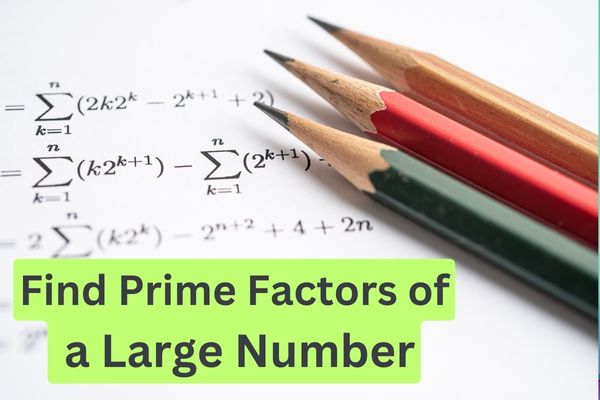how to find prime factors of a large number: Have you ever come around a large number or big number to find its prime factor?
What do I mean by prime factor? Where do we use it? Why prime factor? So, buckle up! Today’s blog will provide you with the knowledge to tackle these questions and unlock the secrets of the prime factor of a large number.
If you want to calculate Prime Factorization then here is the link: Prime Factorization Calculator

What is a prime factor?
There is a straightforward definition that all we know “A natural number which is divisible by 1 or by itself” is called a prime factor.
How to Find Prime Factors of a Large Number: 2 Best Methods
Method 1:
Step 1: Start with the number you want to find its factors.
Step 2: For your large number take the smallest prime number and divide it.
- After dividing if you get the remainder as zero (0) then keep dividing the number and also keep noting down the resulting quotient, until you get the remainder other than zero.
- Once you get the remainder then move to the next step.
Step 3: Now, repeat the step 2 procedure with the different prime numbers until the Quotient reaches a point where no prime number can divide it evenly or we can say when it becomes 1.
Step 4: If the remaining quotient is greater than one (1) is itself a prime factor.
The above approach to finding prime factors is called the Trial division method.
Method 2:
Sometimes, the above trial division method can be an improper procedure to find prime factors of a large number.
Once the number is no longer divisible by 2, proceed division of large numbers with odd numbers. This approach to solving problems is called the “Optimisation method”.
Example: Find prime factors of 7310
Step 1: We start with the given number and that is 7310.
Step 2: Let’s take the smallest prime number 2 to divide the given number
7310 / 2 = 3655
So, this division resulted in remainder 0 and quotient 3655, indicating that 2 is a prime factor of the given large number.
As the remainder was zero according to our step 2 we should continue to divide the number again by 2
3655 / 2 = 1827.5
This resulted in a decimal and indicated that 3655 is not completely divisible by 2.
Step 3: Repeating step 2 with the different prime number
3655 / 3 = 609.16 this also resulted in decimal
The presence decimal indicates that 3 is not the prime factor of the given large number.
Step 4: In this step, we will use the optimization method
We will proceed with division by checking only odd prime numbers only.
Start dividing the above result by 5,7,11 and so on. Until you come around a number that is divided 7310 evenly.
(Note: use a calculator to solve this)
Step 5: If you keep dividing with odd numbers you will get 5,17 and 43 prime numbers that can divide 7310 evenly.
Therefore, the prime factors of 7310 are 2,5,17 and 43. (7,310 = 2x5x17x43).
Prime factors have a wide variety of applications in number theories for studying divisibility, and factorization, and also in cryptography to secure the encryption to secure sensitive data.
They also help optimize the algorithm by finding the Greatest common divisor (GCD). So it was all about how to find prime factors of a large number, if you liked our article then please comment below.
Our Other Calculators